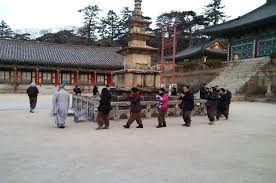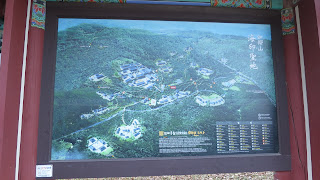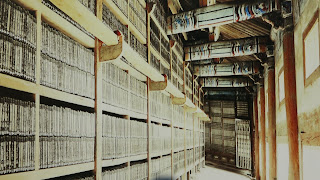Thatching on the walls.
Ehaust from the underfloor heating systems. In this case a wood fire.
Magnificent colors.
Thatch drying for new roofs.
Cotton fields.
Persimmons.
A "simple" breakfast.
Our underfloor heat last night.
We had took bus trips today to get to the Haeinsa Temple. First into the Daegu and then up into the mountains where the temple is located.
Walking the two miles up hill to the temple.
Vendors selling herbs and spices along the way. Incense too.
Andi made it all the way up with luggage. Good on her!
Our accommodations for the night. We were asked to wear traditional costumes for the experience.
We met with the monks and had an orientation,
We went on an after dark walking meditation. The stars were amazing. It was 26 degrees and very cold in the mountains and the monks cut our exercise short. Dinner was vegetarian and very tasty. Lights out at 9PM. Wake up at 4AM.
It was still very cold so we did not attend the morning drum ceremony or meditation. We had breakfast as 6:30AM and then were given a tour of the entire grounds including inside of temples and the Koreana depository. The early light was amazing. No tourists and the grounds to ourselves was special.
Mr. Pak our interpreter.
The Haeinda walking meditation ground.
The original set of woodblocks used to print copies of the Buddhist writings was destroyed by fire during the Mongol invasions of Korea in 1232, when Goryeo's capital was moved to Ganghwa Island during nearly three decades of Mongol incursions, although scattered parts of its prints still remain. To once again implore divine assistance with combating the Mongol threat, King Gojong thereafter ordered the revision and re-creation of the Tripiṭaka; the carving began in 1237 and was completed in 12 years In 1398, it was moved to Haeinsa, where it has remained housed in four buildings. Thousands of scholars and craftsmen were employed in this massive project. The buidlings date back to 702. Where the blocks are stored is very unique.
We departed at noon for two more bus rides to the nearby town of Geong Ju were we will visits the ancient temple mounds of Silla and stay for two nights.


















































































































No comments:
Post a Comment